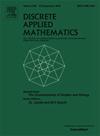n元初始文字和文字洗牌
IF 1
3区 数学
Q3 MATHEMATICS, APPLIED
引用次数: 0
摘要
引入文字和初始文字shuffle操作来模拟两个进程的同步。然而,由于它们的非关联性质,它们不适用于多进程的同步建模。在这项工作中,我们将这两个操作扩展到n元版本,从而支持对多个同步进程进行建模。我们还引入了这些n元洗牌的“迭代”变体,它们不同于之前提出的针对双参数情况的迭代版本。我们研究了形式性质,并证明在一个完整的三人组中,它们的表达能力与一般洗牌操作的表达能力一致。此外,我们还研究了闭包性质,并探讨了由一般洗牌操作的类似问题启发的各种决策问题。例如,确定一个单词是否属于n个单词的n元初始字面洗牌是L中的决策问题,而n元字面洗牌的相应问题是np完全问题。本文章由计算机程序翻译,如有差异,请以英文原文为准。
The n-ary initial literal and literal shuffle
The literal and initial literal shuffle operations were introduced to model the synchronization of two processes. However, due to their non-associative nature, they are inadequate for modeling the synchronization of multiple processes. In this work, we extend both operations to -ary versions, enabling the modeling of multiple synchronized processes. We also introduce “iterated” variants of these -ary shuffles, which differ from previously proposed iterated versions for the two-argument cases. We investigate formal properties and demonstrate that in a full trio their expressive power coincides with that of the general shuffle operation. Furthermore, we examine closure properties and explore various decision problems inspired by analogous problems for the general shuffle operation. For instance, determining whether a word belongs to the -ary initial literal shuffle of words is a decision problem in L, whereas the corresponding problem for the -ary literal shuffle is NP-complete.
求助全文
通过发布文献求助,成功后即可免费获取论文全文。
去求助
来源期刊

Discrete Applied Mathematics
数学-应用数学
CiteScore
2.30
自引率
9.10%
发文量
422
审稿时长
4.5 months
期刊介绍:
The aim of Discrete Applied Mathematics is to bring together research papers in different areas of algorithmic and applicable discrete mathematics as well as applications of combinatorial mathematics to informatics and various areas of science and technology. Contributions presented to the journal can be research papers, short notes, surveys, and possibly research problems. The "Communications" section will be devoted to the fastest possible publication of recent research results that are checked and recommended for publication by a member of the Editorial Board. The journal will also publish a limited number of book announcements as well as proceedings of conferences. These proceedings will be fully refereed and adhere to the normal standards of the journal.
Potential authors are advised to view the journal and the open calls-for-papers of special issues before submitting their manuscripts. Only high-quality, original work that is within the scope of the journal or the targeted special issue will be considered.
 求助内容:
求助内容: 应助结果提醒方式:
应助结果提醒方式:


